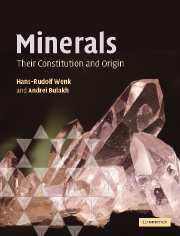Book contents
- Frontmatter
- Contents
- Preface
- Acknowledgments
- Figure credits
- Part I Structural features of minerals
- 1 Subject and history of mineralogy
- 2 Elements, bonding, simple structures, and ionic radii
- 3 The concept of a lattice and description of crystal structures
- 4 Macroscopic symmetries : crystal morphology
- 5 Crystal growth and aggregation
- 6 Isomorphism, polymorphism, and crystalline defects
- Part II Physical investigation of minerals
- Part III Variety of minerals and mineral-forming processes
- Part IV A systematic look at mineral groups
- Part V Applied mineralogy
- Appendices
- Glossary
- References
- Index
- Plate section
- References
3 - The concept of a lattice and description of crystal structures
from Part I - Structural features of minerals
- Frontmatter
- Contents
- Preface
- Acknowledgments
- Figure credits
- Part I Structural features of minerals
- 1 Subject and history of mineralogy
- 2 Elements, bonding, simple structures, and ionic radii
- 3 The concept of a lattice and description of crystal structures
- 4 Macroscopic symmetries : crystal morphology
- 5 Crystal growth and aggregation
- 6 Isomorphism, polymorphism, and crystalline defects
- Part II Physical investigation of minerals
- Part III Variety of minerals and mineral-forming processes
- Part IV A systematic look at mineral groups
- Part V Applied mineralogy
- Appendices
- Glossary
- References
- Index
- Plate section
- References
Summary
Discovery of the lattice
In Chapter 2 we saw how interatomic bonding forces determine the internal structure of crystals. For example, in the case of close-packing in a metal, atoms repeat periodically in three dimensions. A translation of an atom by an interatomic distance superposes it on the next atom. In ionic and covalent structures, the atomic arrangement is more complicated and ion groups or molecules repeat, rather than individual atoms. A regular internal crystal structure was proposed in the eighteenth century, based on some unique macroscopic properties of crystals. The concept of a periodic crystal structure was developed from observations of the plane faces that are observed on freely growing crystals, the characteristic angles between faces, and the regular cleavage that is observed in many minerals. Only much later, in the twentieth century, was it determined that this regular and periodic internal structure was due to the regular bonding forces between atoms.
In 1669, Nicolas Steno discovered that the angles between corresponding faces of quartz crystals are always the same, irrespective of the actual size of the faces. At that time science moved at a slow pace. Over 50 years later, in 1723, Michael A. Cappeller observed that each mineral species has a characteristic set of interfacial angles (these angles can be measured with a protractor) and proposed a law of constant interfacial angles for minerals in general (Figure 3.1).
Information
- Type
- Chapter
- Information
- MineralsTheir Constitution and Origin, pp. 32 - 53Publisher: Cambridge University PressPrint publication year: 2004
